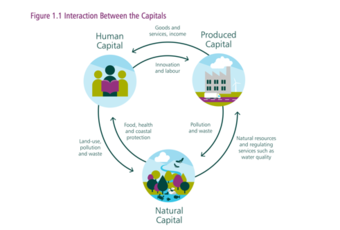In a nutshell, biodiversity loss can create a material risk to the profitability of businesses. As a trustee of a small DC-trust based scheme, considering impacts like this are an important part of my fiduciary duty, much in the same way I’ve focused on the impact of ESG and climate risks on my scheme’s investments.
For those that know me, nature and the environment are very close to my heart, and I’ve been focused on making climate change an important topic of consideration for pension schemes. Climate change happens to be one of the main drivers of biodiversity loss, amplified by the destruction of ecosystems which undermine nature’s ability to regulate greenhouse gas emissions. Restoring biodiversity loss presents an opportunity to help mitigate climate change. Given the thread of this connection between climate change and biodiversity loss, I wanted to frame some of my thoughts on the topic of natural capital and biodiversity, which is going to be a growing area of focus for asset managers and pension schemes alike.
A great example of this close thread between climate change, nature and society was recently reported in the ‘Economist Impact’ – which highlighted that ‘Forests are huge carbon skins, absorbing around 7.6 billion tonnes of carbon dioxide a year, almost one and a half times the amount of carbon that the US emits per year. Global biodiversity is also dependent on healthy forests, which house around 80% of the world’s terrestrial plants and animals. And people rely on forests, which contribute nearly $1.5 trillion to national economies each year’[1].
In 2021, the UK Treasury commission a report[2] that called for changes in our measures of economic success. Put simply, many kinds of natural capital are free to the user - but they are an asset and the report recommended that natural capital is introduced into national accounting systems.
Our interconnectivity with natural capital today is best illustrated in the diagram below.
Why I care personally
 Working with animals gives you a wonderful insight into the different and unique personality traits they have. I compete with horses in a sport known as ‘dressage’ and they are sensitive and emotional animals, capable of forming deep bonds with humans. Having this insight into animal behaviour – and the uniqueness of species - creates a real sense of importance in protecting the animals that live on our planet, and the environment that they rely on to survive.
Working with animals gives you a wonderful insight into the different and unique personality traits they have. I compete with horses in a sport known as ‘dressage’ and they are sensitive and emotional animals, capable of forming deep bonds with humans. Having this insight into animal behaviour – and the uniqueness of species - creates a real sense of importance in protecting the animals that live on our planet, and the environment that they rely on to survive.
I also recognise the really positive social impact that biodiversity has on us as human beings. You only have to take a walk through one of the amazing country landscapes in the UK or relax in an urban park to realise the positive impact that the natural environment has on us as individuals. We are embedded in the natural environment.
And then establishing connections so people can create meaning and understand possibility about climate change and biodiversity is something I really care about. I took my team on a volunteering day at Spitalfields Farm, which focuses on rare breeds and creates a space for the community to enjoy – the farm provides a fabulous way of connecting people to nature. And through this focus on connection, I’m working closely with Mattea Pauc to realise her ambitions for Re-Educating Earthlings, an environment-based education platform she founded that teaches young school children about nature and biodiversity. Education also remains high on my agenda.
Highly balanced
What really fascinates me how ecosystems are self-regulating but they can also be thrown off-balance, creating the conditions for an ecosystem collapse. An example that really resonated with me was Yellowstone National Park. As a result of hunting, wolves became absent in the park back in the 1930’s – it was removed from the local ecosystem. The Elk population then exploded, overgrazing on willows and aspens. Without those trees, the bird population declined, and beavers could no longer build dams, which meant that riverbanks started to erode. Then 25 years ago, the park reintroduced wolves and over time the ecosystem was restored.
In a nutshell, it only takes a small change to move an ecosystem dangerously out of balance.
The scale of the challenge
As our human numbers grew, our impact on the planet increases with them.
We often take the natural environment for granted and don’t recognise that it provides valuable goods and services to society – businesses rely on natural assets such as forests, rivers and soil to function. It’s no surprise therefore, that around half of the world’s total GDP has some dependence on nature. In numbers, this equates to $44 trillion[3].
We’re also seeing a rapid transformation to a full world as we continue to see significant population growth. By 2050, the world’s population is expected to reach 9.7 billion, up from over 7.7 billion today[4], where some 56% live in cities[5] – which creates a distance between us and the natural world. (rural communities are much closer to nature). This places additional pressure on natural resources and education becomes key so we can better understand our engagements with nature. The scale fund funding to reverse the decline in biodiversity by 2030 is also huge – US$722-US$967 billion a year[6] – which requires a significant reallocation of capital to increase our stock of nature and its regenerative rate.
As stewards of capital, asset managers and asset owners have an important responsibility in thinking about their role in protecting nature loss and ecosystems through more engagement with companies that they invest in. What this also means is that nature must be considered as an important factor when assessing risks and opportunities.
Supply chain focus
Stewardship and engagement are going to be key drivers for both asset managers and asset owners. They’ll need a greater level of understanding on how companies they are investing into are considering the impact of nature-related risks across their operations and supply chains.
For asset owners, this means establishing a due diligence framework to understand if their asset managers are thinking about how the companies they hold are interacting with nature and if they are dependent on nature – and reviewing the risks and opportunities. This is where new reporting initiatives, such as the Task Force for Nature Related Financial Disclosures (TNFD) will become increasingly important.
Reporting requirements
With governments focused on reaching net zero targets by 2050, and with the scale of the climate crisis becoming clearer, more regulation is likely to be implemented across both climate and the environment. We’re also beginning to see the emergence of reporting frameworks for natural capital.
In November last year, the Taskforce for Nature-related Financial Disclosures (TNFD) released the third iteration of its framework, which includes draft disclosure recommendations. This incorporates the requirement to report on the negative environmental impact of supply chains. We expect a final draft version of TNFD ths year – and will establish the concepts and definitions for assessment of natural capital in a standardised way, so organisations (and asset managers and asset owners) can report and act on evolving nature-related risks – and integrate nature into decision-making.
Where next?
For me, it’s really positive to see that the topic of natural capital is becoming more familiar across the industry. We have to start somewhere and referencing the challenges and providing insight-led education on the risks and opportunities of natural capital is a good starting point. And then the TNFD reporting frameworks will provide a more structured way of assessing how organisations, asset managers and asset owners are capturing and considering nature-related risks and opportunities.
I think asset owners and asset managers can also start thinking about laying foundations for how they might look at natural capital. This could be building awareness and understanding of natural capital and diversity through to becoming familiar with emerging frameworks, such as TNFD. And for asset owners, it’s starting to think about how to engage with asset managers on the topic to ensure that nature-related risks are being considered as part of the investment process. Some industries, for example, will be more impacted by nature-related risks, such as food, agriculture or manufacturing.
Perhaps a wake-up call for all of us is the World Economic Forum’s Global Risk Report 2023, which highlighted that biodiversity loss and ecosystem collapse is one of the fastest deteriorating global risks over the next decade.
This article was originally published in the Asset Servicing Times Issue 317
[1] https://impact.economist.com/sustainability/ecosystems-resources/progress-on-cop26-pledges-deforestation
[2] https://assets.publishing.service.gov.uk/government/uploads/system/uploads/attachment_data/file/962785/The_Economics_of_Biodiversity_The_Dasgupta_Review_Full_Report.pdf
[3] World Economic Forum
[4] United Nations
[5] https://www.worldbank.org/en/topic/urbandevelopment/overview
[6] https://assets.kpmg/content/dam/kpmg/au/pdf/2021/demystifying-natural-capital-and-biodiversity.pdf




